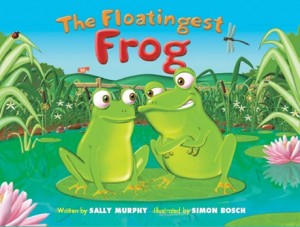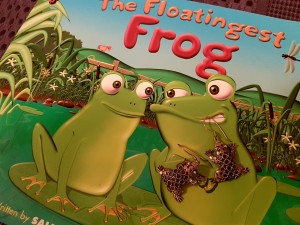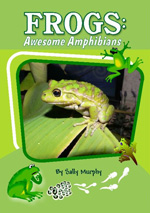Welcome to the third edition of Teacher Tuesday, where I match one of my books to a year level, and offer some activities for sharing the book in the classroom. In the first two weeks I shared activities for Looking Up and for Do Not Forget Australia.
This week I’m focusing on my very first picture book: The Floatingest Frog.
Using The Floatingest Frog in a Year Four Classroom
 The Floatingest Frog, text by Sally Murphy, illustrations by Simon Bosch
The Floatingest Frog, text by Sally Murphy, illustrations by Simon Bosch
Published by New Frontier Publishing, 2004
ISBN: 9781921042546 (Paperback)
Format 24 page Picturebook, RRP $14.99
Available from good bookstores or here.
Blurb: Ferdinand the Frog wants to outdo his brother Frankie in every possible way. He can jump the farthest, croak the loudest, and even has the longest name! Sibling rivalry soon reaches hilarious heights when Ferdinand pushes his luck too far. Based on an Aesop’s fable, The Floatingest Frog is a cautionary tale about being too full of hot air.
Sally’s Recommended Grade Levels: Year K-5, but these suggestions focus on Year 4.
Themes/Topics:
- Siblings

- Frogs
- Animals
- Friendship
- Aesop Fables
- Humour
- Wisdom
Curriculum Links:
Year 4 English
- Recognise how quotation marks are used in texts to signal dialogue, titles and quoted (direct) speech (ACELA 1492)
- Investigate how quoted (direct) and reported (indirect) speech work in different types of text (ACELA 1494)
- During Re-Reading of the book, or using selected pages, ask students to identify how we know a character is speaking. Highlight opening and closing quotation marks, commas and attributions such as said/exclaimed/scoffed.
- Rewrite selected sentences of dialogue on whiteboard or smartboard, demonstrating the correct placement of punctuation.
- Create a worksheet with sentences from the text containing dialogue, with punctuation removed. Have students punctuate appropriately.
- Writing: Write a conversation between Frankie and Ferdinand which does not happen in the book. OR write conversation where Frankie goes to introduce himself to the cow.
- Make connections between the ways different authors may represent similar storylines, ideas and relationships (ACELT 1602): comparing different authors’ treatment of similar themes and text patterns, for example comparing fables and allegories from different cultures
- Discuss how authors and illustrators make stories exciting, moving and absorbing and hold readers’ interest by using various techniques, for example character development and plot tension (ACELT 1605)
- After Reading: Explain that The Floatingest Frog is based on an Aesop’s Fable, The Frog and the Ox. Discuss the elements of a fable – a story designed to teach a moral or message, after using animal characters and explicitly stating the moral.
- Questions: Did any student identify the story as a fable on the first reading? How? Does The Floatingest Frog contain the elements of a fable?
- Read Aesop’s fable: The Frog and the Ox. (There are several versions of this available online)
- In groups/pairs construct a table exploring how the picture book is similar/different to The Frog and the Ox. Suggested headings: length, language, characters, dialogue, statement of moral.
- Discuss: Why might an author use a fable to create a picture book? Which version did students prefer? Why did Sally use two frogs, rather than just one? Why did she change the ox into a cow?
- Examine the book closely – using a story map or other process – to identify how the text attempts to make the original fable more engaging using dialogue, characterisation and action. Examine the illustrations closely to see how the illustrations add to the written words.
- Questions: How has the author used dialogue tags/word choice/repetition/pacing to build an exciting story? Are their things which happen in the illustrations which do not happen in the words? What effect does this have? Why does the word ‘cow’ not appear in the text? How do we know it IS a cow?
- Writing: Retell a different Aesop’s Fable as a narrative.
- Plan, draft and publish imaginative, informative and persuasive texts containing key information and supporting details for a widening range of audiences, demonstrating increasing control over text structures and language features.
- After Reading: Building on work on dialogue and on fables, have students write their own original animal story OR rewritten fable. Work through stages of planning, drafting, editing and publishing this narrative.
Year 4 Science
Biological sciences
- Living things have life cycles (ACSSU072)
- Living things, depend on each other and the environment to survive (ACSSU073)

- The study of The Floatingest Frog can coincide with studies of the life cycle of the frogs. You can find Frog Printables here or at numerous other websites – or make your own.
- Complement The Floatingest Frog with my non-fiction book Frogs: Awesome Amphibians, available here. You can see sample pages of the book HERE
- Compare the language of the nonfiction book with the fiction book, integrating science and literacy activities into the one unit of work.
Other suggestions for using The Floatingest Frog in your classroom include:
- Art/Technology: The art in The Floatingest Frog is created digitally. Experiment with drawing on whichever computer programs are available in your classroom.
- Art: There are many ideas for frog craft, including frog origami. This Pinterest page has links to many easy, clever activities.
- Email the author (that’s me!) Your students can write to me through this website, and share their responses or ask questions.
Related Books
- Frogs: Awesome Amphibians, by Sally Murphy
- The Pros & Cons of Being a Frog, by Sue deGennaro
- Two Frogs, Chris Wormell
- The Orchard Book of Aesop’s Fables, by Michael Morpurgo
- Squids Will Be Squids, by Jon Scieszka
- Unwitting Wisdom, by Helen Ward
Mostly, I’d love to remind you that while I love to see my books used in classrooms, I also love to see kids just enjoying them. Reading a book should be pleasurable – whether it’s being used in the classroom or not. So allow your students to enjoy reading The Floatingest Frog.
If you find this useful, or have any suggestions or comments, do leave a comment. And, if there is a particular book or year level or topic that you would like covered in a future edition of Teacher Tuesday, let me know.